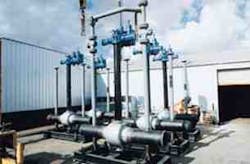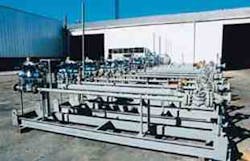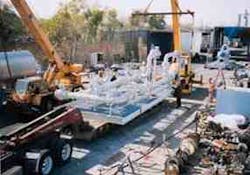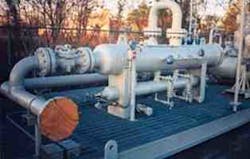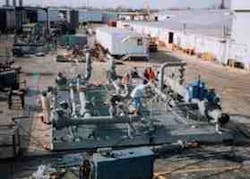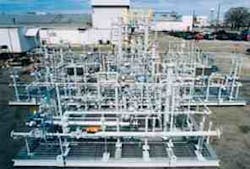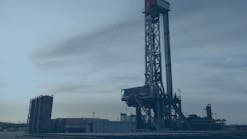Main line block valves on the Mariquita-Cali pipeline are completely modular and prefabricated on a skid with risers and blowdown valves and operator (Fig. 1; Jim Elmore, Houston, photographer).Equipment for the 350 km (217-mile), 20-in. Mariquita-Cali, Colombia, gas pipeline was ordered, fabricated, and shipped within a tight 8-month delivery schedule. Delivery for the final packages of 106 skids of equipment occurred in April.
En-Fab Inc., Houston, received the contract for the equipment mid-July 1995 from Fluor Daniel Williams Bros., Houston. Fluor Daniel holds the engineering, procurement, and management-support contract for the line from Empresa Colombiana de Petroleos (Ecopetrol), Colombia's state oil and gas company.
The pipeline is currently under construction in three spreads with completion and start up slated for first quarter 1997.
Project components
En-Fab says the project consisted of:
- One 20-in. pipeline gas inlet station at Mariquita
- Four 20-in. main line launchers and receivers
- 11 main line block-valve stations with remote-terminal units (RTUs; Fig. 1)
- 3 lateral line block valves
- 32 lateral launcher stations, 2-8 in. (Fig. 2)
- 48 city-gate metering stations, 0.5-77 MMscfd (Fig. 3)
- 34 solar panels to power the remote station's control equipment
- 49 RTU/gas-flow computers used to collect and send information to a supervisory control and data acquisition (scada) control center
- 5 indirect-fired gas heaters
- 43 electric heaters
- 48 filter separators (Fig. 4)
- 48 odorizor stations.
Fluor Daniel Williams Bros. and En-Fab engineered the packages to allow standardization and to follow a design philosophy that involved common arrangements of the equipment to facilitate drawing preparation and fabrication.
Drawings were transmitted over computer modem between Fluor Daniel Williams Bros. and En-Fab in Houston and Fluor Daniel Williams Bros. and the project office in Colombia. Equipment vendors were chosen based on willingness and ability to provide equipment on time and to support the customer during construction.
Vendors to En-Fab were involved from project inception and provided components on a "just-in-time" basis, says En-Fab.
Lateral launchers and receivers await shipment to Colombia. Electrical power will be supplied by solar panels (Fig. 2; Jim Elmore, Houston, photographer).
A city-gate skid is loaded out for crating, while another (background) awaits completion (Fig. 3; Jim Elmore, Houston, photographer).
A skid-mounted filter separator has received some protection for flanges and gauges and awaits further packaging for shipment (Fig. 4; Jim Elmore, Houston, photographer).
Inlet station
The pipeline gas-inlet station includes gas measurement and sampling of the gas entering the distribution system.
Included on the skid are a 20-in. emergency shut-down (ESD) valve, a 20-in. En-Fab intelligent pig launcher, a gas chromatograph, a flanged orifice fitting, and a control panel which includes a flow computer capable of communication via microwave to the scada control center.
The entire skid was completed and tested before leaving Houston (Fig. 5) and ready for installation in Colombia. For ease of operation, says En-Fab, the pig launcher is equipped with a quick-opening closure which included a safety warning device to prevent closure opening under pressure.
A chromatograph is installed on the inlet skid to determine gas composition. It includes a sample-conditioning system, analyzer, and controller. A manual sample valve is installed in the piping to allow gas sampling for laboratory analysis, as needed.
On-line hydrogen sulfide, sulfur, and water content monitors feed signals to the RTU, and the information is sent to the scada control center.
Back up
An uninterruptable power supply system backs up power for the control panel equipment at all city-gate meter stations.
The eleven 20-in. main line block valves, rated at 1,440 psig, 600 ANSI, and actuators are skid mounted and were shipped ready for welding to the line pipe. Also in place were the risers, valve extensions, operators, and blow down valves.
The buried part of the package, which includes the complete valve, a portion of the risers, and part of the valve extension, is coated with coal-tar epoxy.
At each main line block valve site, says En-Fab, an RTU is housed in a solar-powered control panel. The RTU, programmed for safety shutdown, will close the valve on high or low pressure, and on the indication of rapidly dropping pressure.
All shutdown values can be changed in the field by downloading information from a portable computer. The RTU also monitors and records, with time and date, line pressures and all events including shutdowns.
These historical data can be retrieved with the portable computer and/or sent to a central collection point via modem. The design includes provision for scada interface, if desired at a later date.
Launch, receipt
The four 20-in. main line launcher and receiver skids were shipped ready to install. In addition to launcher and receiver, each skid package has a 20-in. main line ESD valve.
The launchers and receivers were designed to accept both intelligent pigs and standard clean-out pigs. A solar-powered control panel, functioning similar to the main line block valve's control panel, is connected to the scada system.
Lateral launcher skids located off the main pipeline include ESD valves. These skids, says En-Fab, serve as the launching point for lateral line inspection and cleaning pigs. A solar-powered control panel, with features identical to that for main line block valves, controls the ESD valve.
City-gate stations
Located at the end of the distribution lines, city-gate stations provide for gas clean up, heating, pressure reduction, odorization, sampling, and measurement (Fig. 6). An ESD valve at the station inlet closes if an unsafe condition develops.
A pig-receiver assembly, immediately downstream of the ESD valve, receives intelligent pigs or clean-up pigs launched from the lateral launcher. A filter separator located downstream of the pig receiver removes 99% of solids of 1 size or larger.
It also removes liquids from the gas stream. The liquid is routed to a sump where it is stored for regular pick up. The filter separator is equipped with a quick-opening closure and safety lock for safe and easy maintenance.
After gas is cleaned, pressure is reduced to the level required for distribution. Cooling of the gas resulting from pressure reduction requires upstream heating to prevent freeze-up of pressure-reducing valves and downstream metering equipment.
Electric or gas-fired heaters are used to provide the needed heat. Electric heaters with low-watt density elements prevent hot spots in the heater housing which is constructed of corrosion-resistant stainless steel. Indirect gas-fired heaters use glycol as heating medium.
Heat is supplied by a forced-draft burner controlled by a burner-management programmable logic controller (PLC). The PLC is located in the heater control panel. This controls the heater with safety signals from the heater and the city-gate station.
Two fail-closed control valves in parallel reduce gas pressure. The valves are set at different pressures. The valve set at higher pressure provides desired control during normal operation.
If a problem should occur with this "primary" valve, it closes, says En-Fab, and the valve set at a lower pressure takes over pressure reducing allowing the system to continue operating uninterrupted. If gas demand exceeds the maximum flow capacity of the primary valve, the second valve opens, and the system continues to operate safely.
Turbine meters are used for gas-flow measurement. They are installed downstream of the heaters and pressure reduction. Some meter stations have a single meter, and others have multiple meters in parallel depending upon the gas requirement.
Meter piping allows for a master meter to be installed to check the accuracy of the line meter. Meter-pulse output, line pressure, and line temperature are input to a flow computer that calculates flow velocity and totals flow. This information is stored for later collection or transmitted via scada to the central data collection point.
Workers assemble a main line block valve on two skids, an arrangement which eases shipment (Fig. 5; Jim Elmore, Houston, photographer).
Small 1 and 2-in. city-gate station skids contain pig receivers, filter separators, pressure reduction, measurement, heaters, samplers, and odorizers (Fig. 6; Jim Elmore, Houston, photographer).
Odorization, power
Odorization systems are integral to each city gate skid, says En-Fab. Each odorizor injects odorant into the distribution system at a readily detectable level and consists of a controller, injection pump, and storage tank.
Injection of odorant is accomplished by the injection system which receives a proportional-to-flow pulse from the flow computer.
The injection system controller controls the injection pump to achieve the desired ratio of odorant to gas flow. If the flow computer signal to the controller fails, the injection system controller will take over pump control and continue to inject odorant at timed intervals.
The storage tank provides a means to inventory odorant at each location. The odorizor and the storage tank are engineered as a "closed loop" system to prevent vapors from escaping to the atmosphere.
The flow computer, in addition to calculating flow and controlling the odorizor, receives all other pertinent information from the city gate station. It monitors liquid level in the filter separator, inlet line pressure, and the line pressures upstream and downstream of pressure reduction.
Power for much of the instrumentation and monitoring systems is provided by solar panels. The control system is assembled as an integrated component of the monitoring and control system enclosure, says En-Fab.
These custom enclosures provide NEMA 3R/4X internal compartments for protection of all systems electronics including RTU, batteries, voltage regulator, and communications equipment as required. Voltage levels of the deep-cycle solar batteries are maintained by regulated input from solar arrays integral to the enclosure.
All power systems have been designed for 14 days of autonomy (period of sunless days). The smaller systems are mountable on 3-in. Schedule 40 steel pipe. The larger systems were manufactured as free-standing units.
Monitoring, control
RTUs monitor and control each site on the pipeline. All units share significant commonality, including low-powered, CMOS-based processors to perform the necessary data collection, evaluation, and reporting to the central location.
All RTUs used for flow and pressure monitoring are field-configurable. Where a location permits, single RTU systems are used for multiple line monitors and valve actuator control.
Functions performed by the RTUs included sensor polling, scaling, and digitization (high, low, increasing and decreasing rate-of-change limits), automatic and operator-initiated valve operation, safety shutdown logic, and data, alarms, and system event archiving.
A multilingual interface via a portable personal computer, says En-Fab, is provided to the field technician for measurement, monitoring, manual valve control, archive log retrieval, and system reconfiguration.
Shipping
The first 20 skids of equipment, including main line block valves, main line launchers and receivers, and the Mariquita inlet skid, were shipped Jan. 3 of this year. Another 40 skids were shipped on Feb. 5.
The final skids of equipment were shipped Apr. 15.
Copyright 1996 Oil & Gas Journal. All Rights Reserved.
